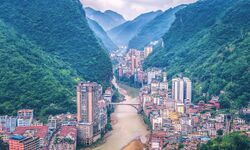Gassavelia
This article is a work-in-progress because it is incomplete and pending further input from an author. Note: The contents of this article are not considered canonical and may be inaccurate. Please comment on this article's talk page to share your input, comments and questions. |
Script error: The module returned a nil value. It is supposed to return an export table.
State of Gassavelia | |
|---|---|
| Country | Urcea |
| Cathedral City | Harzenon |
| Government | |
| • Secretary-General | Aron Mendick (S) |
| Population (2014) | |
| • Total | 89,204,152 |
The State of Gassavelia is one of two states of the Apostolic Kingdom of Urcea. It is the third most populous subidivision of Urcea and the most populous non-crownland unit. It sits in the southeastern corner of Urcea and is bounded by the Hortus Mountains to the northwest, Burgundie to the east, and the Sea of Istroya to the south.
Gassavelia traces its history to the arrival of Ashrafinid dynasty refugees from modern Battganuur fleeing the expansion of the Oduniyyad Caliphate in the 7th century. The area of modern Gassavelia, where these refugees arrived, was relatively lightly populated with Gaelic tribes as well as post-Levantine Latin cities and some outposts of Ancient Istroyan civilization. The Audonian Christians who arrived subdued these peoples and established the Principality of Hištanšahr, though most of the new arrivals and their descendants continued to intermarry with little genetic or religious effect on the people they ruled. In the 11th century, Hištanšahr was incorporated into the Holy Levantine Empire as the Kingdom of Gassavelia, inaugurating a period of cultrual interchange and the rise of the Gassavelian people. Gassavelia as an independent polity experienced significant prosperity during the medieval period, but was subsequently destroyed during the Great Confessional War as it had become a Protestant state in the 16th century. The eastern part of the Kingdom became Faramount whereas the west was granted to House de Weluta and ruled as a series of separate duchies and counties. In the Administrative Reorganization Act of 1892, most of Gassavelia was reunited as a single state and afforded a degree of autonomy reflecting their historic status as the homeland of a unique people, a status which it still retains today.
History
Princely and royal period
Wilderness years
The so-called "wilderness years" of Gassavelia represent its period as a disunited series of polities which, although functionally part of Urcea, were largely separate and ruled individually by the Apostolic King of Urcea. Due to the destruction of the Kingdom faced in the later years of the Great Confessional War and subsequent economic degradation of the Dragonnades, the Gassavelian counties were severely economically depressed. Unlike other parts of Levantia though, very few Protestants would leave the country for Pharisedoms as none existed for their people, instead with most accepting the Catholic faith but out-migration going to other places in Urcea due to the lack of food and employment. During the wilderness years, the territories were largely governed under the mistaken belief that they could be transitioned to a largely agricultural economy common throughout the rest of Levantia, leading to the destruction of many settlements where the rare viable, flat land needed existed. Efforts to grow rice in the area were unsuccessful during the 17th and 18th centuries.
Reorganization
The wilderness years ended with the Administrative Reorganization Act of 1892, which reunited the duchies and counties with significant historical populations of Gassavelian people in them - with the exception of the new province of New Audonia - as the State of Gassavelia.
Geography

Most of Gassavelia sits in a valley between the Hortus Mountains to the west and the highlands of western Burgundie to the east, with the Harzenon River bisecting the country at the lowest point in the valley. The Harzenon River, which is thought to have formed the valley by erosion, is the primary site of human settlement within the state, and the Harzenon River basin makes up a majority of the land area of Gassavelia. Topographically, much of Gassavelia is uneven, with steep declines from the interior country to the rivers which cross the state forming deep canyons in many places. Most of Gassavelia is far above sea level. The significant topographical differences poses a challenge for the typically car-centric lifestyle of most Urceans, and consequently Gassavelians use automobiles less hours per year on average than any other area of Urcea.
Sitting just above the equator, Gassavelia is mostly covered in tropical rainforests and receives a significant amount of precipitation per year.
Cities and towns
Economy
Most of Gassavelia's traditional industries were centered around fishing. Most of the state is not suitable for agricultural development - the Kingdom of Gassavelia's historic agricultural region lay east in Faramount - and accordingly until recent times fishing was the primary source of food for the state. Recent technological innovations have made agricultural endeavors more successful, and farming is a rising industry in Gassavelia. In the 19th and 20th centuries, the state rapidly industrialized and made use of torrential rivers and streams for hydro-power.
